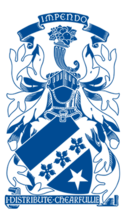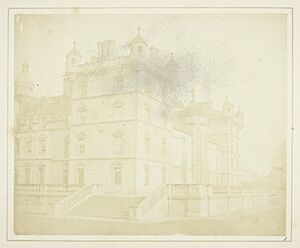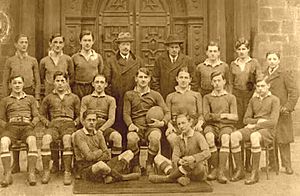George Heriot's School facts for kids
Quick facts for kids George Heriot's School |
|
|---|---|
 |
|
 |
|
| Address | |
|
Lauriston Place
, EH3 9EQ
Scotland
|
|
| Coordinates | 55°56′45″N 3°11′40″W / 55.945918°N 3.194317°W |
| Information | |
| Former name | George Heriot's Hospital |
| Type | Private day school |
| Motto | Impendo (I Distribute Chearfullie) |
| Established | 1628 |
| Founder | George Heriot |
| Oversight | George Heriot's Trust |
| Chairman of Governors | Joyce Cullen |
| Principal | Gareth Warren |
| Staff | approx. 80 |
| Teaching staff | 155 |
| Gender | Co-educational |
| Age | 3 to 18 |
| Enrolment | approx. 1600 |
| Houses | Castle Greyfriars Lauriston Raeburn |
| Colour(s) | Navy Blue, White |
| Song | The Merry Month of June |
| Publication | The Herioter |
| Alumni | Herioters |
George Heriot's School is a private school located in Edinburgh, Scotland. It teaches students from primary to secondary levels. The school is on Lauriston Place in the Lauriston area. In the early 21st century, it has over 1600 students. There are 155 teaching staff and 80 non-teaching staff.
The school was started in 1628 as George Heriot's Hospital. It was founded by George Heriot, who was a royal goldsmith. The school officially opened its doors in 1659. Today, it is managed by George Heriot's Trust, which is a Scottish charity.
Contents
School Buildings and Design
The main building of George Heriot's School is famous for its beautiful renaissance architecture. William Wallace began designing it in 1628. After he passed away in 1631, other master masons like William Aytoun and John Mylne continued the work. In 1676, Sir William Bruce created plans for the central tower. This tower was finally built in 1693.
The school building has turrets and surrounds a large central courtyard called a quadrangle. It is made from sandstone. The first stone was laid in 1628. Each window has unique and detailed decorations. A statue of the school's founder, George Heriot, can be found in the quadrangle.
This main building was the first large structure built outside Edinburgh's old city walls. It is right next to Greyfriars Kirk, which was built in 1620. The school grounds are overlooked by Edinburgh Castle to the north. Parts of the old 17th-century city wall, called the Telfer Wall, are now part of the school's boundaries. When it was first built, the front of the building faced north. People could reach it from the Grassmarket using Heriot Bridge.
In 1833, the other sides of the building were updated with fine stone. This happened when a new entrance was made on Lauriston Place. Alexander Black, who was the Superintendent of Works for the school, managed this project. He later designed the first free schools for Heriot's around the city.
Other important parts of the school include the south gatehouse, designed by William Henry Playfair in 1829. The inside of the chapel was designed by James Gillespie Graham in 1837. The school hall, built in 1893 by Donald Gow, has a special hammerbeam roof. A science block was added in 1887, and a chemistry block in 1911.
The school grounds also have other buildings. There is a wing by Reid & Forbes and a swimming pool, which is not used anymore. A granite war memorial from 1922 honors former students and teachers who died in World War I and World War II.
School History

Early Years: 17th and 18th Centuries
When George Heriot died in 1624, he left a large sum of money. This money was used to start a "hospital," which was a charitable school. It was meant to help "puir, faitherless bairns" (poor, fatherless children) and children of Edinburgh citizens who had fallen on hard times.
Construction of Heriot's Hospital began in 1628. It was built just outside Edinburgh's city walls. During the invasion of Scotland, Oliver Cromwell's English forces used the building as a barracks. They even kept their horses in the chapel. The hospital finally opened in 1659 with thirty children. As the school's money grew, it also took in other students, not just orphans.
By the late 1700s, the George Heriot's Trust bought more land. This included the Barony of Broughton. This land was leased out, bringing in a lot of money for the Trust.
Changes in the 19th and 20th Centuries
In 1846, there was a big event at the Hospital where fifty-two boys were dismissed. This was one of several problems in the 1840s. Some people thought that keeping boys separate from home life in a "hospital" setting was not good. They argued that many boys (only 52 out of 180 in 1844 were truly fatherless) were being left at the school by families who could not care for them.
Duncan McLaren, who became the Lord Provost of Edinburgh in 1851, pushed for changes. He wanted fewer boys in the main Hospital building. He also wanted to expand the "outdoor" schools that Heriot's ran.
Between 1838 and 1885, the Trust opened 13 schools for older children and 8 schools for infants across Edinburgh. These schools did not charge any fees. At its busiest in the early 1880s, nearly 5,000 students attended these Heriot schools. These outdoor schools were later sold or rented out after 1885. This happened as part of reforms to the Trust and as public schools became more common. Many of these outdoor school buildings had designs similar to the main Lauriston Place Hospital building.
George Heriot's Hospital was central to debates about Scottish education funding from the late 1860s to the mid-1880s. At that time, it was hard to get government money for secondary education. So, reforming existing school funds was seen as a way to help more students get an education beyond elementary school. The big question was: who should benefit? Those who could pay fees, or those who could not?
In 1885, a commission used its power to make changes at Heriot's. The Hospital became a day school that charged a small fee for boys aged 10 and older. Up to 120 "foundationers" (children who had lost a parent) could still attend for free. These foundationers had special admission. The new George Heriot's Hospital School focused on modern and technical subjects. The network of outdoor schools was closed. The money saved was used for scholarships and bursaries. Some of these helped students attend the High School and the University of Edinburgh.
The "Watt Institution and School of Arts" was taken over by the Trust in 1885. It was renamed the Heriot-Watt College. This was part of a plan to encourage technical education in Edinburgh. The school and the college were run by the same board until 1927. In 1966, the college became a university, known as Heriot-Watt University.
In 1979, George Heriot's School started admitting girls, becoming co-educational.
Modern Era

Today, George Heriot's has about 1600 students. It continues its charitable mission by offering free education to children who have lost a parent. These students are called "foundationers." In 2012, the school was ranked as Edinburgh's best-performing school based on Higher exam results.
School Leaders
Here is a list of the headmasters and principals of the school, with the year they started their role.
- 1659 James Lawson
- 1664 David Davidsone
- 1669 David Browne
- 1670 William Smeaton
- 1673 Harry Moresone
- 1699 James Buchan
- 1702 John Watson
- 1720 David Chrystie
- 1734 William Matheson
- 1735 John Hunter
- 1741 William Halieburton
- 1741 John Henderson
- 1757 James Colvill
- 1769 George Watson
- 1773 William Hay
- 1782 Thomas Thomson
- 1792 David Cruikshank
- 1794 James Maxwell Cockburn
- 1795 George Irvine
- 1805 John Somerville
- 1816 John Christison
- 1825 James Boyd
- 1829 Hector Holme
- 1839 William Steven
- 1844 James Fairburn
- 1854 Frederick W. Bedford
- 1880 David Fowler Lowe
- 1908 John Brown Clark
- 1926 William Gentle
- 1942 William Carnon
- 1947 William Dewar
- 1970 Allan McDonald
- 1983 Keith Pearson
- 1997 Alistair Hector
After 1997, the title of Headmaster changed to Principal.
- 2014 (January) Gareth Doodes
- 2014 (September) Cameron Wyllie (Acting)
- 2014 (December) Cameron Wyllie
- 2018 (January) Mrs Lesley Franklin
- 2021 (August) Gareth Warren
Sports and Activities
George Heriot's School has many sports and extra-curricular activities. Former students have clubs like the Heriot's Rugby Club and Heriot's Cricket Club. These clubs use the school's Goldenacre grounds. The George Heriot's School Rowing Club competes nationally and is part of Scottish Rowing. The school also has a pipe band, and about 120 students take music lessons.
Famous Former Students
Many notable people have attended George Heriot's School. They are often called "Herioters."
Academia and Science
- George Alexander Carse (1880 – 1950) - a physicist.
- J. W. S. Cassels, FRS (1922 – 2015) - a mathematician.
- Henry Daniels, FRS (1912 – 2000) - a statistician.
- Robin Ferrier (1932 – 2013) - an organic chemist.
- Sir George Taylor (botanist) (1904 - 1993) - a botanist.
- Sir Thomas Dalling (1892 - 1982) - a professor and Chief Veterinary Officer.
- John Borthwick Gilchrist (1759 – 1841) - an expert in Indian studies.
- Professor Sir Abraham Goldberg (1923 – 2007) - a medical professor.
- Professor Hyman Levy (1889 – 1975) - a philosopher, mathematician, and activist.
- Sir Harry (Work) Melville (1908 – 2000) - a polymer chemist.
- Professor Hamish Scott FBA FRSE (born 1946) - a historian.
- Professor Gordon Turnbull - a psychiatrist.
- Professor Douglas C. Heggie (born 1947) - a professor of mathematical astronomy.
- Alexander Burns Wallace (1906–1974) - a plastic surgeon.
Media and Arts
- Nick Abbot (born 1960) - a radio broadcaster.
- Ian Bairnson (born 1953) - a musician.
- Emun Elliott (born 1983) - an actor.
- Gavin Esler (born 1953) - a television journalist.
- Mark Goodier (born 1961) - a radio disc jockey.
- Mike Heron (born 1942) - a musician.
- Roy Kinnear (1934 – 1988) - an actor.
- Duncan Hendry (1951 - 2003) - a chief executive in performing arts.
- Iain Macwhirter (born 1953) - a journalist.
- Henry Raeburn (1756 – 1823) - a famous painter.
- Ian Richardson (1934 – 2007) - an actor.
- Mike Scott (musician) (born 1958) - a musician and composer.
- Alastair Sim (1900 – 1976) - an actor.
- Ken Stott (born 1955) - an actor.
- Bryan Swanson (born 1980) - a Sky Sports chief reporter.
- Nigel Tranter (1909 – 2000) - a historical novelist.
- Robert Urquhart (1921 – 1995) - an actor.
- Charlotte Wells - a film director.
- Paul Young (actor) (born 1944) - an actor.
Law and Politics
- Tasmina Ahmed-Sheikh (born 1970) - an SNP politician.
- Euan Duthie, Lord Duthie (born 1975) – a Scottish judge.
- James Mackay, Baron Mackay of Clashfern (born 1927) - a former Lord Chancellor.
- David McLetchie (1952 – 2013) - a former leader of the Scottish Conservatives.
- Doug Naysmith (born 1941) - a Labour politician.
- Keith Stewart, Baron Stewart of Dirleton - HM Advocate General for Scotland.
- Gordon Prentice (born 1951) - a Labour politician.
- Stephen Woolman, Lord Woolman (born 1953) - a Senator of the College of Justice.
- Kenneth Borthwick CBE DL JP (1915 – 2017) - a former Lord Provost of Edinburgh.
- Sir Adam Wilson (1814 – 1891) - a former mayor of Toronto.
Sports
- Bruce Douglas (born 1980) - a Rugby Union player.
- Charles Groves (1896–1969) - a cricketer.
- Andy Irvine (born 1951) - a Rugby Union internationalist.
- Iain Milne (born 1956) - a Rugby Union player.
- Kenny Milne (born 1961) - a Rugby Union player.
- Robert More (born 1980) - a cricketer.
- John Mushet (1875–1965) - a cricketer.
- Gordon Ross (born 1978) - a Rugby Union player.
- Ken Scotland (born 1936) - a Rugby Union internationalist.
- Polly Swann (born 1988) - a Rowing World Champion.
- Douglas Walker (born 1973) - a sprinter.
Military
- Colonel Clive Fairweather (1944 – 2012) - second in command of the SAS during the Iranian Embassy siege.
- David Stuart McGregor (1895 – 1918) - a Scottish recipient of the Victoria Cross.
Religion
- Graham Forbes, CBE (born 1951) - Provost of St Mary's Cathedral, Edinburgh.
- Hector Bransby Gooderham (1901 – 1977) - a priest.
- Gordon Keddie (born 1944) - a Reformed Presbyterian minister and theologian.
- James Pitt-Watson (1893–1962) - a theologian and Moderator of the General Assembly of the Church of Scotland.
- Brian Smith (bishop) (born 1943) - Bishop of Edinburgh (Scottish Episcopal Church) 2001–2011.
Other Notable Alumni
- James Aitken, aka "John the Painter" (1752 – 1777) - a mercenary.
- Hippolyte Blanc (1844 – 1917) - an architect.
- Archie Forbes (1913 – 1999), CBE - a Colonial administrator.
- Norman Irons (born 1941) - a former Lord Provost of Edinburgh.
- Sir Andrew Hunter Arbuthnot Murray (1903 – 1977) - a former Lord Provost of Edinburgh.
- Stuart Harris (1920 – 1997) - an architect and local historian.
- Fiona Ritchie - British High Commissioner to Malawi from 2022.





